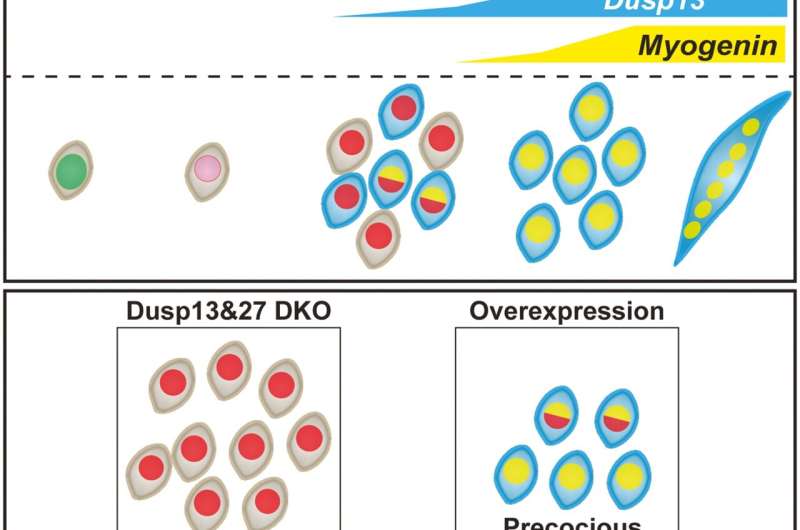This article has been reviewed according to Science X's editorial process and policies. Editors have highlighted the following attributes while ensuring the content's credibility:
fact-checked
peer-reviewed publication
trusted source
proofread
Researchers elucidate the switch molecule in muscle stem cells that initiates muscle formation

Researchers at University of Tsukuba have made a significant contribution to the understanding of the regeneration of skeletal muscle stem cells, shedding light on the mechanisms underlying muscle aging and regeneration.
Using mouse models, they discovered that two enzymes, DUSP13 and DUSP27, are crucial in regulating the transition of skeletal muscle stem cells from proliferation to differentiation. These enzymes are directly controlled by the muscle differentiation regulator MYOD, and their absence results in delayed muscle regeneration.
This discovery, now published in Stem Cells, opens new avenues for developing treatments for sarcopenia, which is characterized by muscle weakness and loss of muscle mass.
Japan's aging population urgently needs methods to prevent musculoskeletal diseases. Skeletal muscles, which are essential for physical activity, deteriorate in both volume and function with age, reducing the quality of life. To counteract muscle aging and preserve muscle regeneration capabilities, the pivotal role of stem cells, particularly skeletal muscle stem cells, in muscle tissue must be understood.
Under normal conditions, adult skeletal muscle stem cells remain dormant. They are activated and multiply in response to muscle damage to facilitate repair and regeneration. Delays or abnormalities in this process can disrupt muscle regeneration, accelerating muscle aging.
The research team has been investigating the factors that activate and stimulate the proliferation of skeletal muscle stem cells and those that induce the transition of these proliferating cells to the muscle differentiation stage.
For this study, researchers used mice in which they were capable of distinguishing the activation state of skeletal muscle stem cells to analyze gene expression during the quiescent, proliferative, and differentiated phases. Analysis of the mice revealed that DUSP13 and DUSP27 act as switches, inducing proliferating skeletal muscle stem cells into a differentiation stage.
Furthermore, these enzymes are directly regulated by the muscle differentiation regulator MYOD. Mice lacking the genes for these enzymes exhibited delayed muscle regeneration due to a malfunction in the muscle differentiation switch.
The findings of this study can potentially contribute to the development of drugs for treating muscle weakness and muscle mass loss that are characteristic of sarcopenia.
More information: Takuto Hayashi et al, Dual-specificity phosphatases 13 and 27 as key switches in muscle stem cell transition from proliferation to differentiation, Stem Cells (2024). DOI: 10.1093/stmcls/sxae045
Journal information: Stem Cells
Provided by University of Tsukuba




















